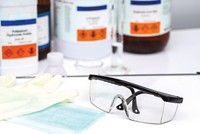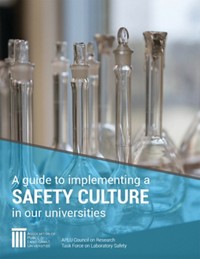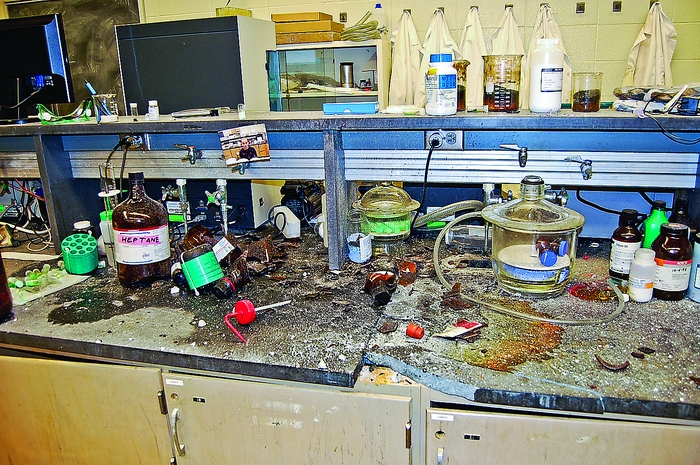Advertisement
Grab your lab coat. Let's get started
Welcome!
Welcome!
Create an account below to get 6 C&EN articles per month, receive newsletters and more - all free.
It seems this is your first time logging in online. Please enter the following information to continue.
As an ACS member you automatically get access to this site. All we need is few more details to create your reading experience.
Not you? Sign in with a different account.
Not you? Sign in with a different account.
ERROR 1
ERROR 1
ERROR 2
ERROR 2
ERROR 2
ERROR 2
ERROR 2
Password and Confirm password must match.
If you have an ACS member number, please enter it here so we can link this account to your membership. (optional)
ERROR 2
ACS values your privacy. By submitting your information, you are gaining access to C&EN and subscribing to our weekly newsletter. We use the information you provide to make your reading experience better, and we will never sell your data to third party members.
Lab Safety
Wanted: Data to make labs safer
Researchers aim to supply evidence to save lives, persevering through lack of recognition and funding
by Benjamin Plackett, special to C&EN
March 30, 2020
| A version of this story appeared in
Volume 98, Issue 12

If there’s a watershed moment in the history of laboratory safety research, it may be the 2009 death of Sheharbano “Sheri” Sangji, a 23-year-old research assistant who died from injuries sustained in a University of California, Los Angeles, chemistry laboratory fire.
Since then, laboratory scientists as well as health and safety professionals have tried to improve laboratory safety at various institutions. In doing so, “we should be giving evidence-based guidelines” rather than defaulting to adding more compliance forms, says Michael Blayney, executive director of research safety at Northwestern University.
But experts say they’ve been hampered by a lack of research on the subject.
The dearth of data is not because people lack motivation to study safety. “Not to sound too noble or pompous, but I think you’ll find people in this field are working because we want to make industry and academic labs safer, because we want to save lives,” says Paul Amyotte, a professor in the Department of Process Engineering and Applied Science at Dalhousie University.
Imke Schroeder is a research project manager at the University of California Center for Laboratory Safety, which was set up in 2011 after Sangji’s death. “Our intention is to make research a safer pursuit for everyone, not just in California or the United States, but worldwide,” Schroeder says.
But there are barriers to such altruism. Those trying to meet the need for evidence must overcome hurdles in terms of number of researchers, recognition, and funding, they say.
“It’s not a traditional research field for people in academia,” Amyotte says. “It sometimes feels like you can count the names of researchers on one hand,” he says. With so few people involved, “it’s a challenge to advance the field.”
Safety research is not that different from other fields of science, Amyotte emphasizes. It often follows a similar form and methodology. For example, his research could be categorized as basic or fundamental science, he says.
“We’re working with marginally explosive materials, which means it’s something that sometimes explodes and sometimes doesn’t, depending on the scale,” he says.
In process safety, materials’ explosive properties are typically tested in tanks of two sizes—20 and 1,000 L. But testing at the smaller scale is much cheaper, so industry tends to rely on 20 L test data when deciding how to store, treat, and process materials. However, some materials that explode at the smaller scale don’t at the larger scale, even at the same concentration.
“Which do you believe? The 20 L data? OK, well you may be putting expensive safety measures in place that aren’t needed,” Amyotte says. “But heaven forbid you don’t and there’s an explosion. That’s why we’re trying to get some good and more complete data” on substances such as urea, polyethylene, and various metals. Amyotte’s group is also doing theoretical modeling to try to understand what’s behind the differences in behavior at the two scales. It’s fundamental science research, he says, “but it also has clear implications for safety.”
Others are working more directly on research laboratory safety. The University of California set up the Center for Laboratory Safety as a means to foster research and effectively evaluate new safety measures that the UC system wanted to deploy, according to Schroeder and Craig Merlic, a chemistry professor at UCLA and the center’s executive director.
“Good science is science done well,” Merlic says. “And science done well is science done safely.”
Schroeder’s research currently focuses on whether a principal investigator’s risk perception and lab behavior influence student safety and behavior in the lab. “Are students’ attitudes towards safety affected by what the PI is doing?” Schroeder asks. “We want to know more about what type of PI actions have an effect on safety outcomes.”
Her work is based mainly on surveys, which she analyzes to quantify PI attitudes’ impact on the wider lab’s safety record.
For example, experienced PIs who have never had a serious accident could become complacent in their risk perceptions and consequently less stringent about following safety protocols. That could put less-experienced students at risk if they copy the PIs’ behaviors. Schroeder expects to publish the work this year.
Given that the goal of research such as Amyotte’s and Schroeder’s is to save lives, one might expect that securing funding would be easy, for either moral or financial reasons.
“If you think safety is expensive, then try an accident,” says Marc Reid, a chemistry research associate at the University of Strathclyde, quoting an old adage. Reid’s research focuses on improving safety training in the chemical manufacturing industry. “Things like compensation, lawyers’ fees, and reputational damage really start to add up when things go wrong.”
But neither educational nor governmental institutions tend to be well set up to fund safety research, according to researchers working in the field. It’s simply not as easy to sell the idea of safety research to would-be funders as it is to sell, say, a hunt for a cancer cure.
“You’re trying to get money to do research in order to make nothing happen,” Amyotte explains.
This can make it tough for safety researchers to identify appropriate funding sources and justify the cost of the research. Amyotte recommends focusing on the ways that safety is similar to other research fields in terms of solving problems and generating knowledge.
For his part, Amyotte is funded by the Natural Sciences and Engineering Research Council of Canada. Canada’s federal government is exceptional in its recognition of safety as a legitimate area of research, he says.
In contrast, the UC Center for Laboratory Safety is funded directly by the University of California through a “center of excellence” grant. In the beginning, the center gave grants to researchers across the US to tackle projects such as tracking safety culture metrics, identifying hazards associated with compounding medications in pharmacy teaching labs, and assessing exposure controls for nanomaterials synthesis. “That endeavor was interesting, productive, and successful, but we don’t have enough funds to continue doing that,” Schroeder says. She and her colleagues at the research center are pursuing additional support from nonprofit organizations like the Camille and Henry Dreyfus Foundation, which seeks to advance the chemical sciences.
The story is different in industry. “My managers really encourage me to do my safety research,” says Qiang Yang, a scientist at Corteva Agriscience who recently published a paper investigating runaway reactions involving sodium hydride combined with certain solvents (Org. Process Res. Dev. 2019, DOI: 10.1021/acs.oprd.9b00276).
Part of the difference may be similarity of work across labs within a company, so a research project clearly benefits many. That contrasts with a university setting, where “the risk assessments can be different in every lab,” says Christopher Incarvito, a chemist and director of research operations and technology at Yale University.
Also, “When you have to scale up operations as you often do in industry, you really need to evaluate safety hazards to protect staff,” Yang says.
The University of Strathclyde’s Reid would like to see more communication and collaboration on laboratory safety between academic and industrial researchers. He thinks that more dialogue between the two communities would help make scientists safer in all settings.
“Accidents happen in both camps with unpalatable regularity,” Reid says. “It is essential we blur any boundaries and focus on learning best safety practices from one another.”
In addition, being able to cite safety findings from any source enables safety advocates to discuss issues in a way that scientists are familiar with, says Brandon Chance, a chemist and director of environmental health and safety at Southern Methodist University.
Nevertheless, safety research originating in industrial labs is not a substitute for studies that specifically look at academic lab safety. Those in charge of ensuring lab safety on campuses say they require data from those environments to generate evidence-based guidelines, such as those that Northwestern’s Blayney desires, and to persuade researchers to follow them. For example, if Schroeder can demonstrate that lax safety behavior is infectious, that may help convince experienced staff that they need to set an example.
The need for environment-specific data may help ease the work of studying safety, and in some ways the environment is already improving. “Twenty years ago, it was near impossible to get people to understand what I do,” Amyotte says. “It’s getting better.”

Benjamin Plackett is a freelance writer based in the UK. A version of this story first appeared in ACS Chemical Health and Safety: cenm.ag/researchingsafety.





Join the conversation
Contact the reporter
Submit a Letter to the Editor for publication
Engage with us on Twitter